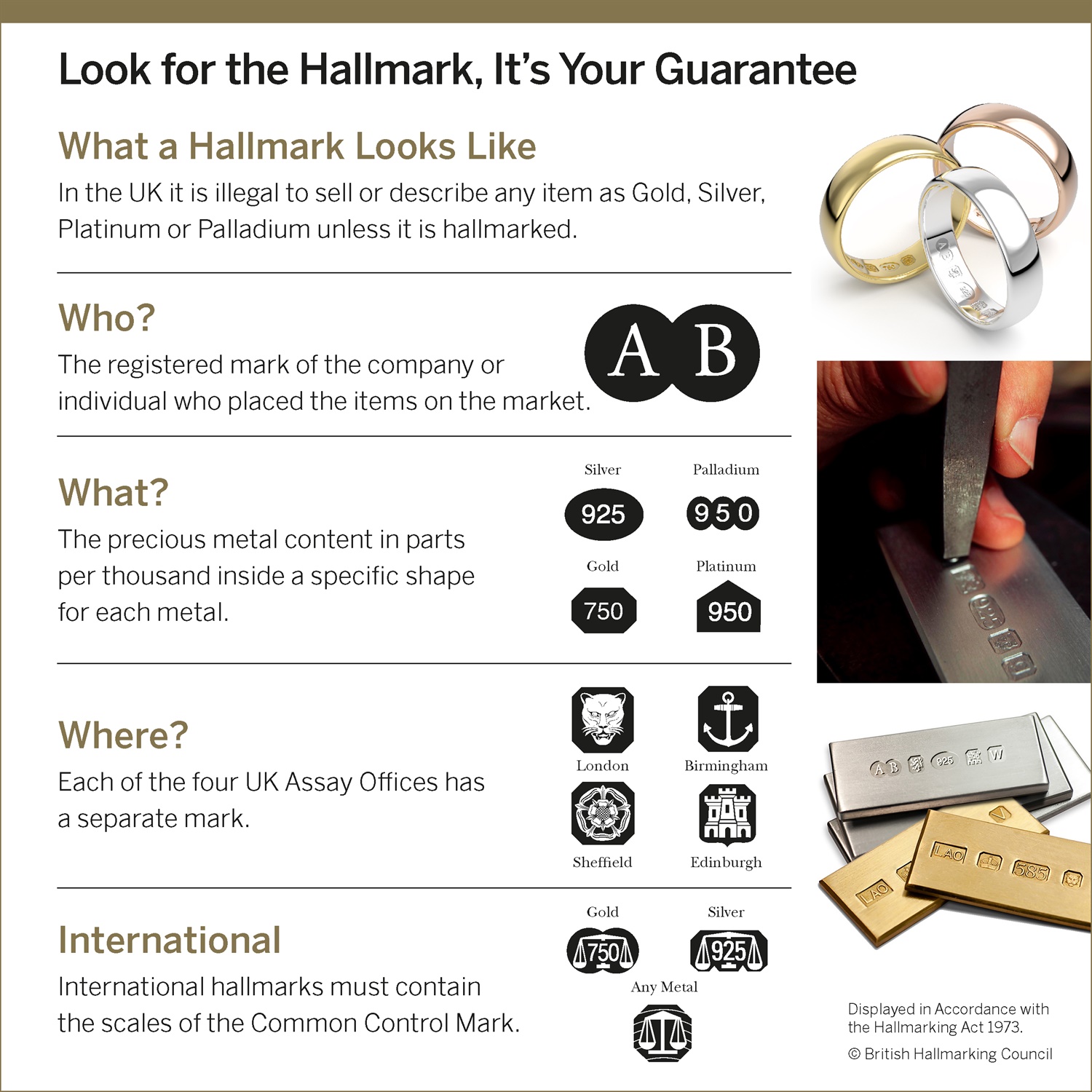A mark of authenticity and craftsmanship that has withstood the test of time, British Hallmarking is a practice which not only ensures the purity of precious metals but also stands as a testament to the unwavering commitment to excellence and heritage.
Unravelling The Hallmarking Legacy
Hallmarking, as we know it today, has its roots in the 13th century when King Edward I of England decreed that all gold and silver articles must be assayed and marked to ensure their quality. This noble initiative aimed to protect consumers from fraudulent practices and uphold the reputation of skilled artisans.
Fast forward to the present day, British jewellery hallmarking remains a time-honoured tradition, carried out by The Goldsmiths' Company Assay Office, a venerable institution that has been serving the trade and consumers since 1300.
What Is A Hallmark?
The hallmark itself is a set of tiny component marks which are applied to all types of jewellery which are made from precious metals. Precious metals refer to Platinum, Gold, Palladium & Silver.
The hallmark is often found in discrete locations like the inside of a ring band or on the clasp of a necklace. Each hallmark tells a unique story about the piece's composition and the artisan behind its creation. British hallmarking carries its own distinctive symbols, these serve as a mark of trust and quality, providing consumers with confidence in their purchase.
There are three compulsory marks which must be on all items being sold as one of the four precious metals. This mark is called the Minimum Compulsory UK Hallmark. These are the Sponsors Mark, Millesimal Fineness Mark & the Assay Office Mark.
There are four other additional marks which are optional. These are Traditional Fineness Mark, Date Mark, Commemorative Marks and Convention Mark.
A Full UK Traditional Hallmark consists of five marks: Sponsors Mark, Traditional Fineness Mark, Millesimal Fineness Mark, Assay Office Mark and Date Letter Mark.
A Sponsors Mark, also known as a 'Makers Mark is a compulsory mark.
This mark represents the registered company that submitted the jewellery for hallmarking.
Each sponsors mark is unique, allowing you to trace the item back to its original source.
At Kayes, our Sponsors Mark is 'MK' pictured here.
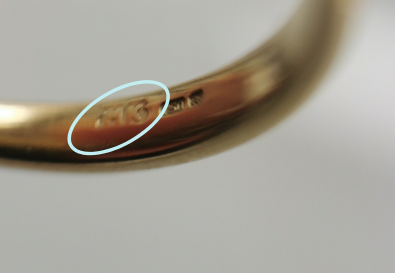
The Millesimal Fineness Mark is a compulsory mark. This mark tells you the content of precious metal within your item, expressed in parts per thousand.
Each type of metal has a number in a different shaped shield.
The Assay Office always mark a piece to the lowest standard of precious metal.
This guarantees the quality of the item will be no less than the fineness described.
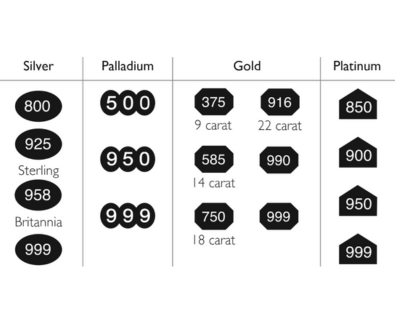
The Assay Office Mark is a compulsory mark telling you which Assay Office tested and hallmarked the item.
In the UK, there are four Assay Office where every item must be tested & hallmarked.
These are: London (Leopard), Birmingham (Anchor), Sheffield (Tudor Rose), and Edinburgh (Castle).

In addition to the Millesimal Fineness Mark, you may also see a Traditional Fineness Mark.
This is not a compulsory mark, but is applied as standard at the London Assay Office.
From left to right: Sterling Silver, Britannia Silver, Gold, Palladium, Platinum.
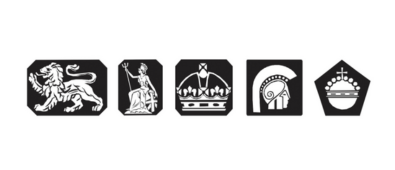
The Date Letter Mark became optional in 1999, so most modern jewellery pieces may not commonly have this mark.
Every year on January the 1st, the date letter changes and the old stamp is destroyed.
The font, letter & shield case change, making it possible to identify what year the item was assayed.
Pictured are date marks from 2019-2024.

Commemorative Hallmarks are given to pieces to mark special national events.
They are an optional hallmark, but are a useful indication to the age of the item as the mark relates to a special date in time, usually highlighted by a portrait.
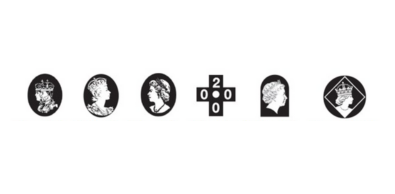
The Convention Mark, also known as the Common Control Mark is used by countries which are signatories to the International Convention on Hallmarking.
This provides a safeguard for the trade of jewellery across borders by hallmarking internationally recognised 'Control Marks'.
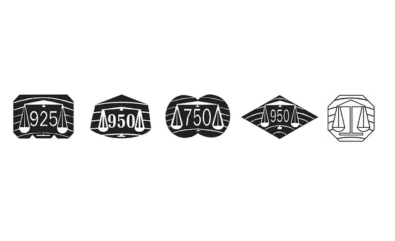
How Is Jewellery Hallmarked?
There are two ways to hallmark jewellery, stamp and laser.
Traditionally, the hallmark was always stamped on to the item however, if the item was of a delicate nature, stamping the hallmark could cause the item to become slightly distorted.
Nowadays, most jewellers & manufacturers opt for the laser. The popularity for intricate designs and diamond set bands has increased over the years, by having the hallmarked lasered, this means that the more finer & delicate items will not be distorted.
If a ring has a laser hallmark and needs resizing, it is possible that the item will need to be sent back to the Assay office to be re-hallmarked. This is because, when a ring is resized it needs to be re-polished
Where Are Hallmarks Placed?
Hallmarks are usually placed in a discreet place. On rings, the hallmark will be inside the shank, on other items such as necklaces or earrings, the hallmark will be placed on the earrings posts, or on the fastening of a necklace.
Preserving Legacy and Empowering Consumers
British hallmarking stands as a beacon of trust and assurance for consumers. By upholding this age-old tradition, jewellers not only honour the heritage of their craft but also empower customers with the knowledge that their treasured piece is genuine, authentic, and of the highest quality.
As we celebrate the art of British jewellery hallmarking, let us remember that it is not just a stamp on metal; it is a celebration of centuries of excellence, a tribute to master craftsmen, and a timeless symbol of the enduring legacy of the jewellery trade. Whether you're adorning yourself with a cherished heirloom or indulging in a sparkling new piece, the hallmark reminds us all of the unique story behind every exquisite creation.
For any further questions regarding hallmarking, please do not hesitate to contact us and one of our jewellery experts will be in touch.
